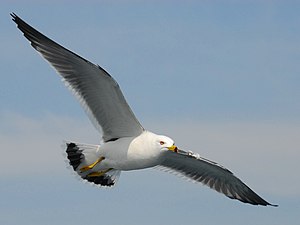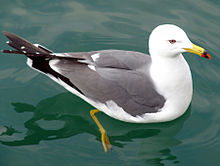Japanese gull
| Japanese gull | ||||||||||||
|---|---|---|---|---|---|---|---|---|---|---|---|---|

Adult Japanese gull ( Larus crassirostris ) with a characteristic, wide tail band |
||||||||||||
| Systematics | ||||||||||||
|
||||||||||||
| Scientific name | ||||||||||||
| Larus crassirostris | ||||||||||||
| Vieillot , 1818 |
The black-tailed gull ( Larus crassirostris ) is a bird art within the gulls (Larinae). It breeds on the coasts of southeast Russia , eastern China , Korea and especially Japan , where it is the most common great gull.
Within the genus Larus it belongs to a rather original group of four species, which wear a dark tail band in all clothes and show relatively simple beak drawings and almost completely black hand wings in adult dress.
description
The Japanese gull, with a body length of 46 to 48 cm, a wingspan of 118 to 124 cm and a weight of 436 to 640 g, is one of the smaller species of the genus Larus and is slightly larger than a common gull . The tail wears a dark band in all age-old clothes and is quite short, the wings appear relatively long and slender.
In the breeding dress the head, neck and underside are white, the upper side is dark slate gray in color. The relatively slender, yellow beak is bright red at the tip and wears a black subterminal band . The pale yellowish iris is surrounded by a dark red orbital ring . The legs and feet are yellow. The tail has a characteristic, black subterminal band that is quite wide and can only be found in a similar shape in the South American Simeon's gull ( Larus belcheri ). The trailing edge of the wing is white, as with all Larus species, but ends in the form of fine, white tips on the inner wings of the hand. The distal hand wing is therefore almost completely black; only a few birds have an inconspicuous, white subterminal field on the outer hand wing. In winter, the back of the head and eye region are darkly dashed, the dashed lines can condense into a clearly pronounced neck band.
Birds in youthful dress are predominantly dark brown and appear scaly on top due to light feather hems. The beak is flesh-colored with a sharply defined black tip. The plumage is slightly lightened on the front head, the eyes are framed by distinctive, white half-rings. In contrast to other great gulls, the banding on the large arm covers is missing. The tail is black with a white lace border. The legs are flesh-colored.
Birds in the first winter are very similar to those in their youthful plumage. The mantle and shoulder feathers are drawn less contrasting and thus appear lighter. A strong, dark drawing is striking on the lower wing.
The second winter dress already communicates with the adult dress and shows gray back feathers and gray middle arm covers. The face, base of the beak and the iris are sometimes significantly brighter than in the first winter. The tail is still mostly black.
Birds in the third winter are distinguished from adults by the dark feather centers of the hand covers. In the following summer they can no longer be distinguished from adults.
voice
The call is a deep, cat-like kaou-kaou or jark-jark-jark . In addition, a plaintive, rough reputation is described. Because of this voice, the Japanese seagull is called umineko ( ウ ミ ネ コ , English "monkey") in Japan .
Distribution and existence
The breeding areas of the monotypical species are mainly on the coasts and islands of the Japanese and Yellow Seas , where the seagull species occurs in Korea, the Chinese province of Shandong , in Japan and in eastern Russia. 96 percent of the Russian population breed on the island of Furugelma in Peter the Great Bay , where there are several colonies with a total of 80,000 breeding pairs. There are other deposits on Sakhalin , the southern Kuriles and Moneron .
The species is not endangered, the world population is estimated at more than 350,000 breeding pairs or 1,100,000 adult birds. There are 150,000 breeding pairs in Japan and 100,000 in Russia.
hikes
Outside of the breeding season, the species occurs in a more extensive area around the breeding areas. Birds in the first year pass into nutrient-rich areas. Russian birds mainly gather on the Tatar Sound , birds from Honshū migrate to the Japanese Pacific coast or the southern Okhotsk Sea . Yellow Sea birds migrate north and south along the coast. The main wintering areas are on the Korea Strait , the Sea of Japan, and the northeast China coast. The species is less common in the south, but appears as a regular winter visitor up to around Hong Kong .
The species has been observed as a rare stray visitor in North America, where some evidence has even come from the east coast.
Way of life
The Japanese gull inhabits coasts, bays and estuaries. The breeding colonies are located on sandy or rocky beaches, cliffs or rock islands. The food changes locally and seasonally in its composition, but consists mainly of smaller fish, crustaceans , insects and waste, in addition to molluscs and polystyrene . In winter, fishing waste is very important, the species also likes to follow fishing boats out to sea. Landfill sites are also used. Kleptoparasitism was not infrequently observed.
Japanese gulls are found in the breeding colonies from mid-April, and eggs are laid in Siberia between May and June. The nest is built in the sand or on rocks made of dry grass. The clutch consists of two to three eggs, which are incubated for between 24 and 25, less often 27 days. The young birds fledge after about 35 to 40 days. The departure rate is 63 to 70 percent. When the chicks leave the nesting site, a high percentage of neighboring adult birds are killed.
literature
- Klaus Malling Olsen, Hans Larsson: Gulls of Europe, Asia and North America , Helm Identification Guides, Christopher Helm, London 2003 (corrected new edition from 2004), ISBN 978-0-7136-7087-5
- Josep del Hoyo , Andrew Elliott, Jordi Sargatal (eds.): Handbook of the Birds of the World. Volume 3: Hoatzin to Auks. Lynx Edicions 1996, ISBN 978-84-87334-20-7 , p. 602.
- Gerald S. Tuck, Hermann Heinzel : The sea birds of the world. Paul Parey Publishing House, Hamburg / Berlin 1980, ISBN 3-490-07818-7 .
- Pierre-Andre Crochet, Jean-Dominique Lebreton, Francois Bonhomme: Systematics of large white-headed gulls: Patterns of mitochondrial DNA variation in western European taxa , The Auk 119 (3), 2002, pp. 603-620
Individual evidence
- ↑ Olsen / Larsson (2003), p. 33, see literature
- ↑ a b c d Del Hoyo et al. (1996), p. 602, see literature
- ↑ a b c d e Olsen / Larsson (2003), p. 37, see literature
- ↑ BirdLife Species Factsheet , accessed July 4, 2011
Web links
- Larus crassirostris in the endangered Red List species the IUCN 2009. Posted by: BirdLife International, 2008. Accessed July 4 2011th
- Videos, photos and sound recordings of Larus crassirostris in the Internet Bird Collection


